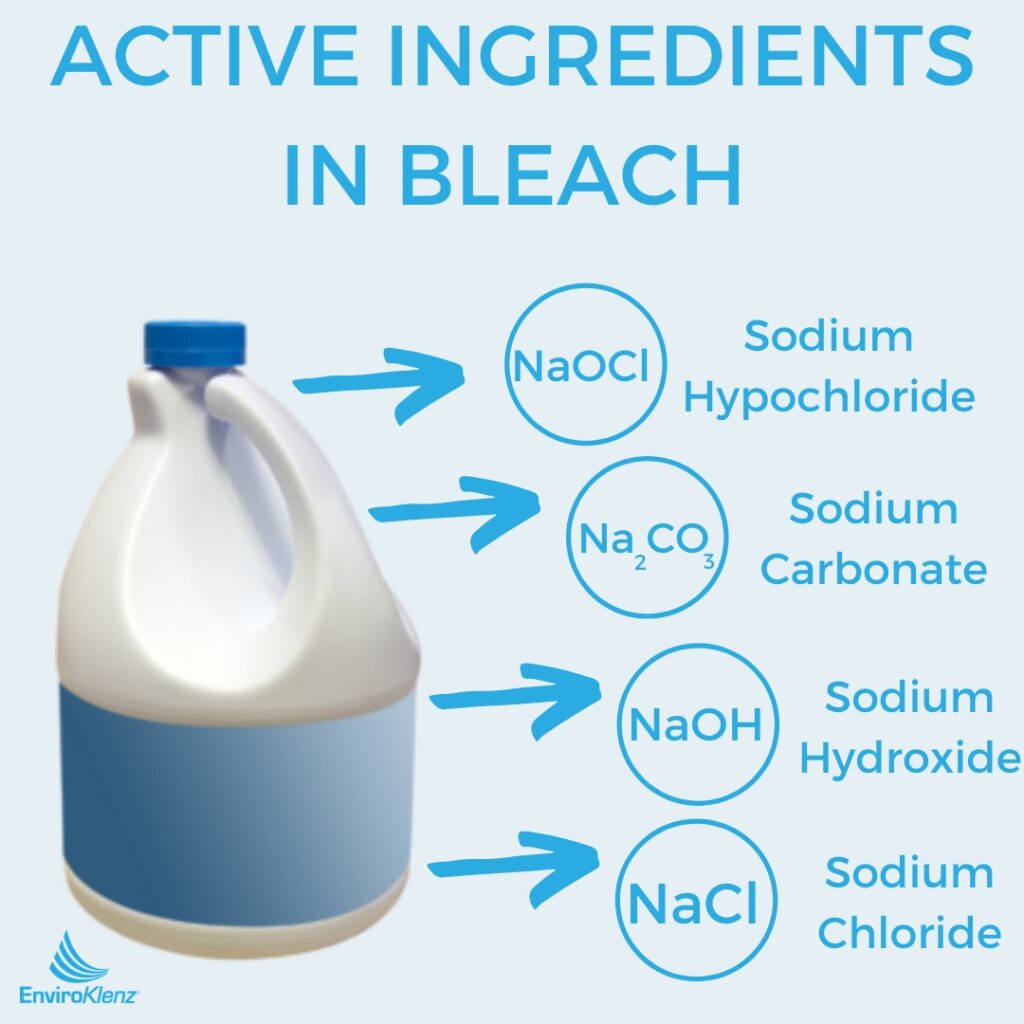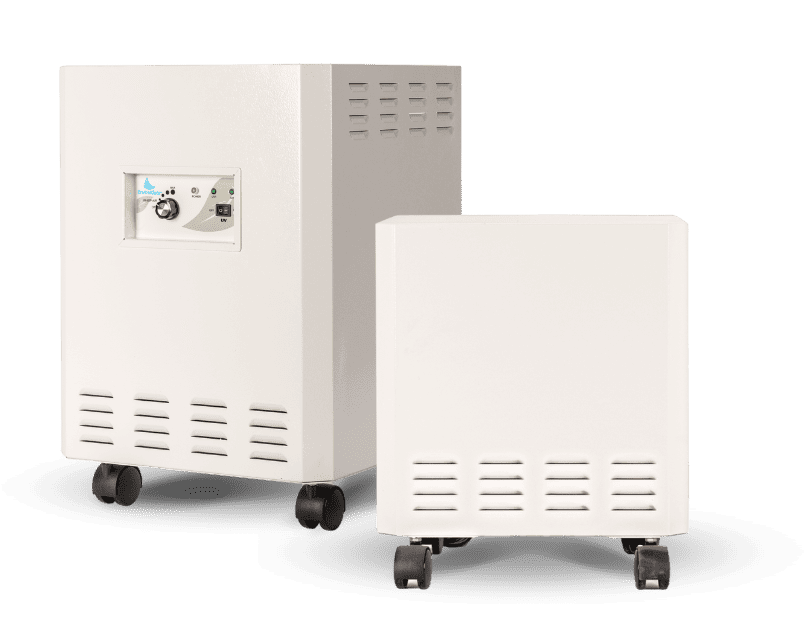The power of bleach is endless and when it comes to cleaning and disinfecting the surfaces inside of your home, people continually use bleach to remove a variety of germs from these surfaces. Whether it be disinfecting your home after a member of your family has battled a virus or even cleaning up bodily fluids like urine or vomit that has been released into your home, bleach can be used due to its chemical composition that allows for this cleaning agent to work as a disinfectant solution. Bleach will work specifically to kill the germs from the surfaces in which have become contaminated by viruses and/or bacteria, and therefore it has become the staple product for most homes when it comes to sanitizing and disinfecting the indoor space.
Today, with the high risk of virus and bacteria exposure, especially from the current pandemic sweeping not only the United States but the entire world – taking proper sanitation and disinfecting procedures within your home can be necessary for protecting the environment and the health of the occupants. As many individuals are now housed in their homes during the recommended self-quarantine period, the use of bleach may become beneficial in fighting off pathogens that can invade this indoor space and compromise health.
In this article we are going to learn more about bleach and its ability to kill viruses and other pathogens from the environment, as well as discuss the best methods to use to mitigate and remove the fumes that are produced from bleach inside of a home.
What is Bleach
Household bleach is a major part of most households when it comes to chemical agents used to both disinfect and remove stains from surfaces, such as in the laundry to remove stains on clothing materials. There are two main classes of household bleach; chlorine bleaches and non-chlorine bleaches. These two classes of bleaches will work as oxidative agents that will form a reaction when they come into contact with certain stains, certain germs or other organisms, and sometimes even clothing dyes. This very useful chemical agent can be used both around the house and/or for large-scale use in commercial spaces such as hospitals and hotels, due to its powerful capabilities when it comes to disinfecting.
Many bleaches have broad spectrum bactericidal properties that make for this cleaning agent to be a useful disinfectant and sterilizing agent to control bacteria and viruses that may accumulate on surfaces. According to Wikipedia, a 1-in-5 dilution of household bleach with water (1 part bleach to 4 parts water) is an effective solution against bacteria and some viruses which has made this a popular choice for disinfecting surfaces, particularly in hospitals throughout the United States. This diluted household bleach has been found to disinfect surfaces within 10 to 60 minutes of contact time, allowing for quick and effective sanitation of household surfaces.

Active Ingredients in Bleach
When it comes to the chemical composition of bleach there are several active ingredients in bleach that will give this chemical cleaner/disinfect its most important capabilities. Chlorine bleach usually contains sodium hypochlorite, the active ingredient for bleaching, stain removal and disinfecting properties. In addition, other chemical ingredients can include sodium chloride, sodium carbonate, and sodium hydroxide. When it comes to killing germs, sodium hypochlorite uses the same quality that it does for stain removal – which is acting as a powerful oxidizing agent.
When this chemical [sodium hypochlorite] comes into contact with viruses, bacteria, mold, or fungi, it will work to oxidize the molecules in the cells of the germs and will kill them, according to How Stuff Works. Additionally, scientists have also found that the hypochlorous acid that forms when sodium hypochlorite is placed in water can break down the cells walls of certain germs. And when it comes to bacteria the hypochlorous acid will cause proteins to build up in bacteria and make the cells unable to function.
Uses of Bleach
Bleach is used primarily as a disinfectant, not as a cleaner, because of its ability to effectively kill germs on the surfaces. This cleaning agent can be used on a surface where you will scrub and rinse the surface first and then apply the bleach solution to sanitize the surfaces. Often times when we smell the aroma of bleach we will firstly think of the smell of bleach as cleaner; however, it is not a cleaner. This disinfect can be applied to a variety of surfaces including the kitchen counters, cutting boards, bathroom counters, tubs, sinks, door handles, knobs, flooring, and any water-safe surfaces that you may be concerned about inside of your home.
After bleach has been used and applied to surfaces it is important that you allow the bleach solution to have a full 10 minutes of contact time to ensure complete disinfection of the surface. Once this 10-minute contact time has occurred it is necessary to rinse and dry the surface due to the fact that it can be irritating to the skin and mucous membrane for both occupants and pets in the indoor space.
Does Bleach Kill All Germs?
When it comes to disinfecting and killing germs that have contaminated the surfaces of your indoor spaces such as your home, many people will turn to bleach to disinfect and sanitize these surfaces. This relatively cheap and highly disinfectant cleaner will work to kill some of the most hazardous bacteria – including staphylococcus, streptococcus, E.coli, and salmonella, as well as many viruses such as the flu and common cold, according to WebMD. Bleach has long been the recommended solution to disinfecting hard, non-porous surfaces due to its chemical composition and effective destruction capabilities when it comes to viruses, bacteria, and other pathogens in the environment.
The United States Center for Disease Control & Prevention (CDC) has long promoted the use of bleach for killing a variety of germs in an indoor space on a variety of surfaces. The recommended mixture of bleach to use for disinfecting surfaces within an indoor environment is a combination of 1/3 cup of regular chlorine bleach (sodium hypochlorite) bleach per gallon of water. It is important, however, that when you are conducting these bleach sanitations on surfaces it is necessary to wear protective equipment such as gloves, protective eyewear, and other protective wear so that the bleach does not come into contact or exposure with the human skin.
How Long Does Bleach Stay Active on a Surface
The application of bleach when it is used on surfaces is an effective method that can do its intended job of killing germs such as viruses and bacteria on these specific areas. When it comes to using bleach, the first step will be to clean the intended surfaces before applying bleach to remove debris from the area. After these surfaces have been cleared of debris a bleach solution can then be used on the surface, but it is important to allow for this bleach solution to sit for at least 10 minutes. This contact time will allow for the bleach to become exposed to these various germs on the surface and allow for the bleach to begin its process of inhibiting and destroying these pathogens from the surface.
In addition, when it comes to the amount of time after bleach is applied that it will stay active on the surface, this timeframe can be an ambiguous figure. However, according to research from the World Health Organization (WHO), diluted household bleach will disinfect and stay active on a surface within 10 to 60 minutes after contact time. Therefore, the capabilities of bleach are fairly powerful in disinfecting and sanitizing these surfaces within our most precious indoor spaces such as our homes.
Dangers of Bleach Fumes
If you have ever used heavy amounts of bleach inside of your home than you will be well aware of the strong bleach fumes that can flood this indoor air space that may even provoke certain adverse health reactions in those exposed to these fumes within a confined space. Bleach toxicity will depend on a number of factors such as the amount of bleach used, the size of the space, and the airflow and ventilation inside these spaces. Additionally, bleach can also be extremely hazardous when this chemical disinfectant agent is mixed with other household cleaners such as toilet bowl cleaners and ammonia, especially for those who are breathing in bleach fumes within their homes.
The fumes that are produced from bleach that is used inside of a small confined environment can be debilitating to the health of those individuals exposed to these airborne chemical fumes. According to a publication called, Bleach Toxicity, the bleach fumes can have a direct impact on the eyes, mouth/throat, skin, stomach, and respiratory system from inhaling bleach.
- Eyes: If bleach fume exposure occurs it can cause redness, irritation, or tearing of the eyes; this may result in blurry vision.
- Mouth/throat: Slight irritation, unless the bleach has become ingested into the human body.
- Skin: Mild irritation can be possible for bleach fume exposure.
- Stomach: A rare symptoms from bleach fume exposure inside of a home, since the GI tract is resistant and resilient to this type of chemical exposure.
- Respiratory: Irritation can occur such as bronchospasm, however, this is only with extreme exposure.
How to Get Rid of Bleach Fumes
A strong bleach smell can infiltrate a room, and this is due to the heavy bleach fumes that can be released from the use of bleach in this indoor space. If you have begun to disinfect nearly every surface within your home, then the bleach odors can become completely overwhelming and will therefore require the addition of air flow and ventilation in the space. Air flow and ventilation are key components in mitigating and controlling air pollution levels, as well as chemical fume odors present in the environment. Therefore, it is recommended that you try to open windows and doors in your home when you are dealing with high chemical levels in the air or abrasive chemical odors such as bleach fumes.
Additionally, air purifiers can be a great resource to use to remove chemical odors from the air, as well as mitigate airborne pollutants such as chemicals, noxious odors, particulate matter, and even microorganism destruction in some air purifiers that utilize specific technologies. When it comes to air purifiers there can be a variety of different technologies used in each air purifier, whether that be carbon, ozone, ionizers, and other proprietary technologies. The EnviroKlenz UV Air Purifier is among the proprietary technologies that utilize their own patented earth mineral technology. The EnviroKlenz earth mineral technology is a non-toxic blend of earth minerals that work to capture, contain, and neutralize a broad spectrum of noxious and toxic chemicals and odors from the air, such as VOCs. In addition, the EnviroKlenz Air Purifier contains a second stage of filtration that utilizes a hospital-grade HEPA filter for fine particulate removal larger than 0.3 microns in size. This air purifier also contains two UVC lights that are placed strategically in-between the two filters within the EnviroKlenz Air Purifier which allows for microorganisms to be effectively destroyed as the UVC light shine upon the collection plate of the HEPA filter. Thus, allowing the EnviroKlenz UV Air Purifier to remove airborne pathogens from the air such as viruses, bacteria, and mold spores that can become airborne in your home’s air.
Article Sources:
- Wikipedia: Bleach (link)
- How Stuff Works: Chlorine Bleach as a Disinfectant (link)
- WebMD: Killing Flu Germs: What Works? (link)
- Centers for Disease Control and Prevention (CDC): Coronavirus Disease 2019 (COVID-19) (link)
- World Health Organization (WHO): Infection Prevention and Control of Epidemic- and Pandemic-Prone Acute Respiratory Infections in Health Care. (link)
- National Center for Biotechnology Information (NCBI): Bleach Toxicity (link)









